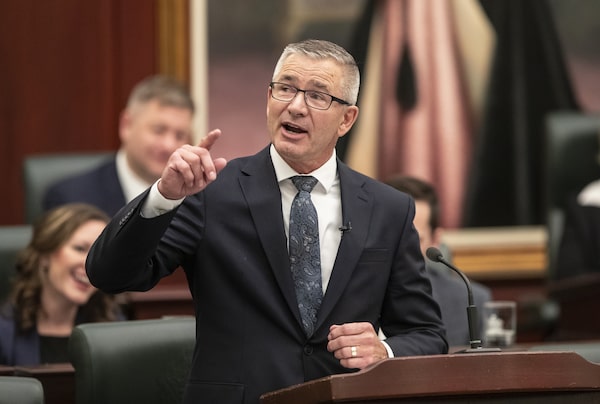
Alberta Finance Minister Travis Toews delivers the province's 2023 budget, in Edmonton on Feb. 28.JASON FRANSON/The Canadian Press
British Columbia and Alberta went into their 2023 budgets from a similarly strong position. The Western neighbours emerge heading in divergent fiscal directions.
The big, economically powerful provinces both tabled their new fiscal plans Tuesday, coming off stellar years in which they both banked enormous budget surpluses. (Alberta’s $10.4-billion of black ink is the most in history; B.C.’s $3.6-billion is the second-biggest surplus on record.) Their resource- and export-heavy economies have benefited from strong commodity prices and the global economy’s rapid recovery from the COVID-19 pandemic. Both boast the two lowest debt-to-GDP ratios in the country – less than half the levels of Ontario and Quebec.
But what the two provinces definitely do not share is a political landscape. That’s apparent in the strikingly different paths they have chosen from their enviable financial position.
Alberta’s United Conservative Party government sees the financial health as its chance to get off its boom-and-bust budgetary hamster wheel, and establish sustainably balanced budgets. For B.C.’s ruling New Democratic Party, it’s an invitation to ramp up spending, especially in critical areas such as health care and housing.
Alberta’s budget lays out a plan for the surplus to dwindle to $2.4-billion in the 2023-24 budget year – a year in which an economic slowdown will take a bite out of every government’s finances. But it anticipates running modest surpluses through 2025-26, which is the full extent of the budget’s fiscal plan.
But the current government has its eye on sustained balances well beyond that horizon. The budget lays out a new “fiscal framework” that would prohibit deficits, other than in exceptional circumstances – namely, surprise slumps in revenue or unforeseen expenses. Even in such exceptions, the government would have just two years to return to balance.
The government also proposes capping annual growth in operating expenses at no more than the rate of inflation plus the rate of population growth. That would mean that inflation-adjusted per capita spending wouldn’t grow at all.
B.C.’s budget does not share Alberta’s tight-belted tone at all. The province has budgeted for a deficit of $4.2-billion in 2023-24 – its second largest in history – followed by only slightly smaller shortfalls in the two years beyond that. It will give rebates to housing renters, and ramped up spending on health care and infrastructure. Over the course of the three-year plan, the government expects its debt-to-GDP ratio to rise to 23 per cent from the current 16 per cent.
“It’s just not the right time to start making cuts,” B.C. Finance Minister Katrine Conroy said in a postbudget news conference.
The very divergent directions the two provinces are taking certainly reflect the philosophical foundations of the parties in government. Alberta’s UCP and B.C.’s NDP are definitely in character with these budgets.
But Alberta’s austerity also reflects some pretty deeply held values of the people of the province. Many Albertans found the province’s six-year run of large deficits and swelling debts from 2015-16 to 2020-21 not just problematic, but upsetting. The province has a long and proud history of healthy finances and low-to-no government debt; the drift further and further away from that for several painful years was an alarming challenge to many people’s sense of Alberta’s identity. It felt like the province was becoming something they didn’t want to be: financially weak and needy.
The fiscal framework that the UCP has presented attempts to better protect the province from straying down this same road again. It recognizes that the province’s finances are prone to booms and busts, and that it needs to build some defences around its finances against those forces.
It also aims to protect the government from its own worst instincts. Past Alberta governments – most of which were, in name, conservative – had an appalling habit of spending their found money during boom times, only to plunge the province into deficits and painful cuts when, inevitably, oil markets turned sour and revenues dried up. The framework will force a discipline that Alberta governments have sorely lacked.
With Alberta approaching a legally mandated fixed election date this spring, this also looks to be a stance on which Premier Danielle Smith’s party is prepared to go to battle. It will paint itself as the defender of fiscal prudence, in contrast to an NDP Opposition that, it will argue, blew up Alberta’s finances when it was in power before and will do it again.
British Columbia is still a year and a half from the next vote. Premier David Eby is still working on living up to the NDP’s promises from the last election. The subsidy for renters was one such pledge. The government has a bit of time to pursue the agenda for which it was elected, and is coming off a couple of good years that have given it the means to pay for it.
Regardless of the reasons, the different paths the two provinces will follow present quite the case study to witness in real time over the next few years. We’ll see the consequences of a big-spending government turning its fiscal muscle on the problems of today, versus a thrifty government determined to bulletproof its finances for the economic shocks and uncertainties of tomorrow.